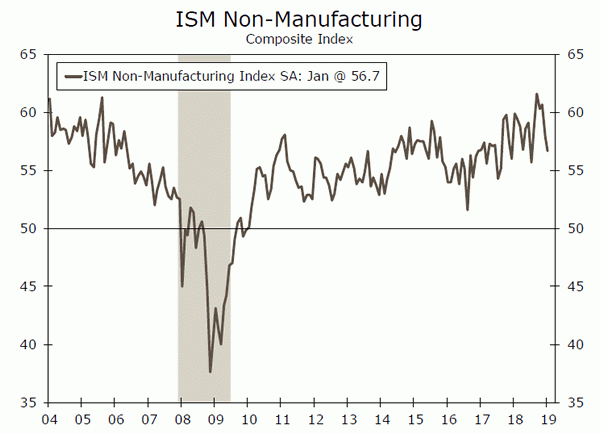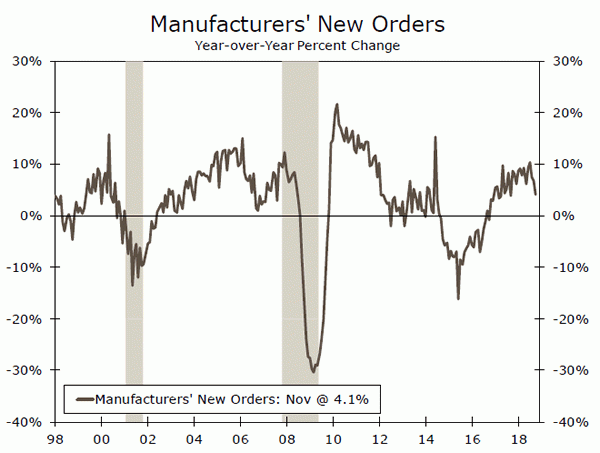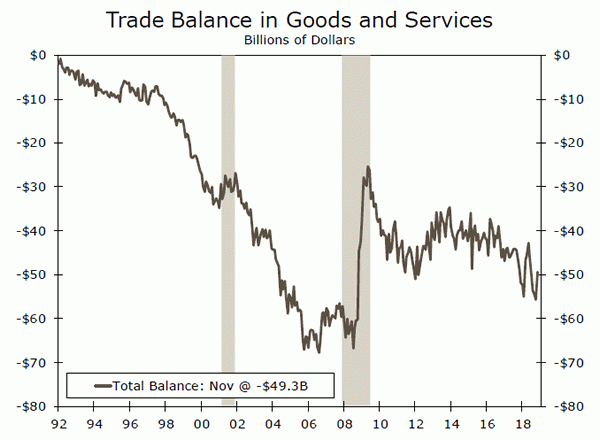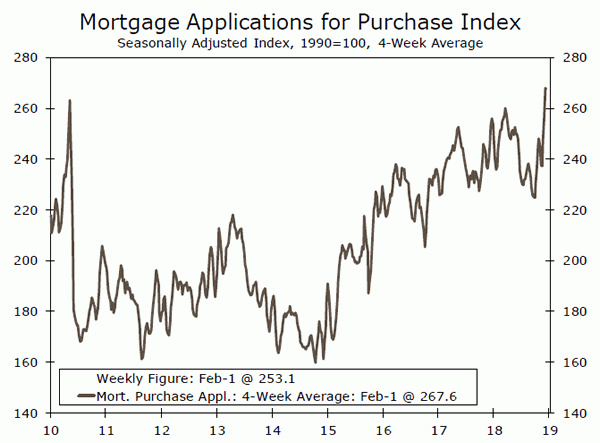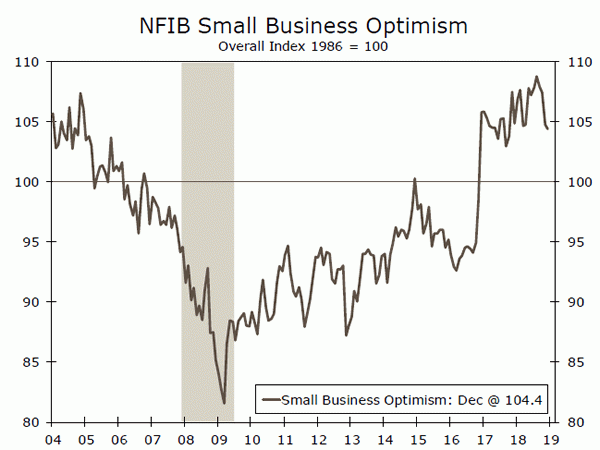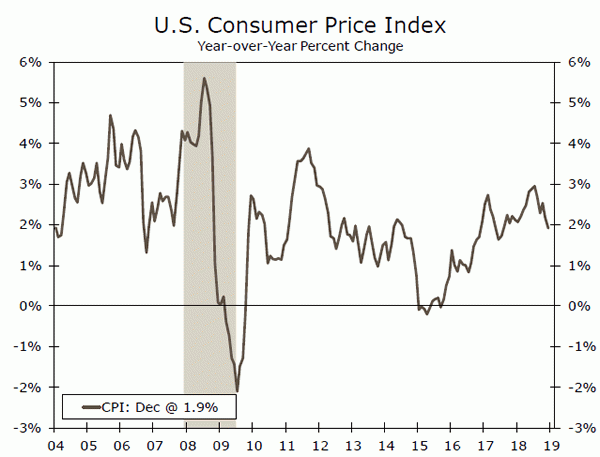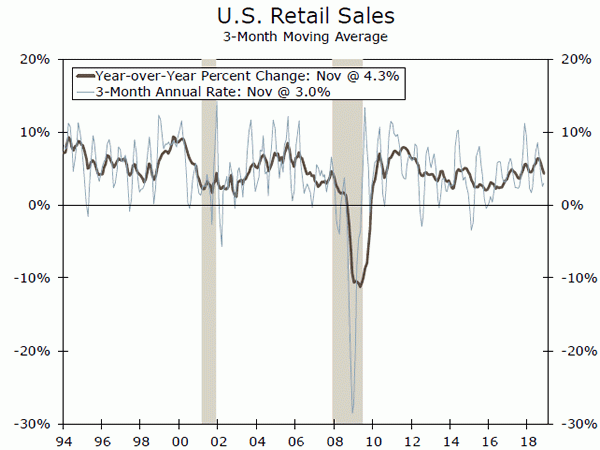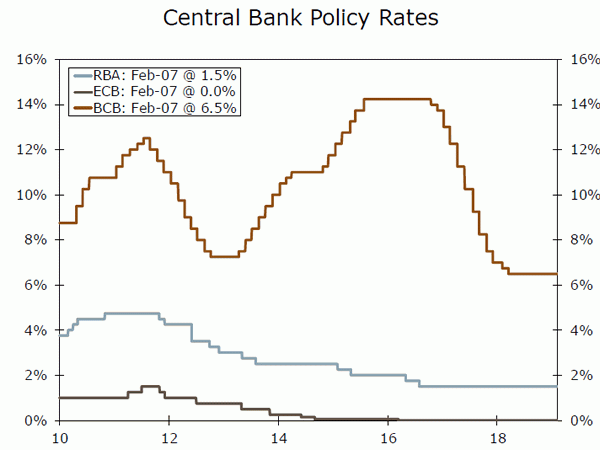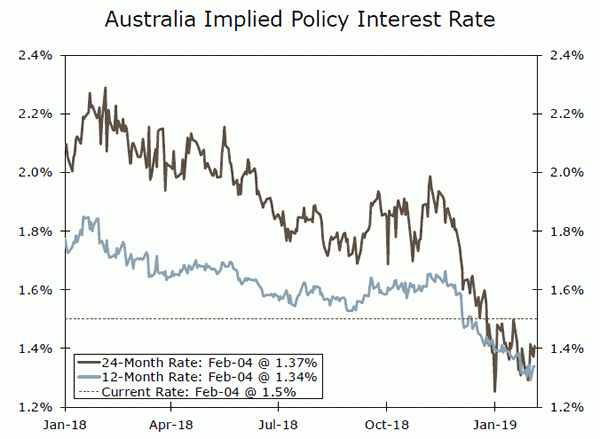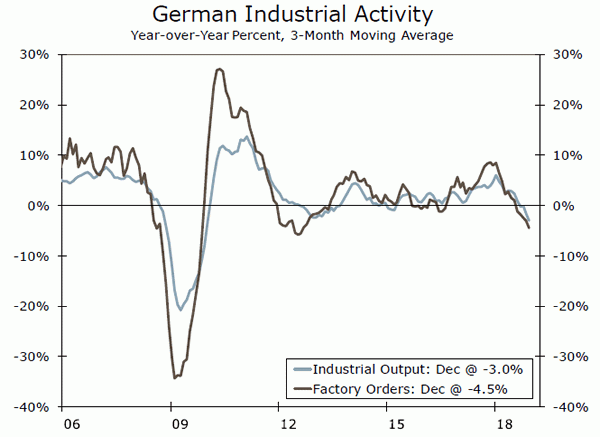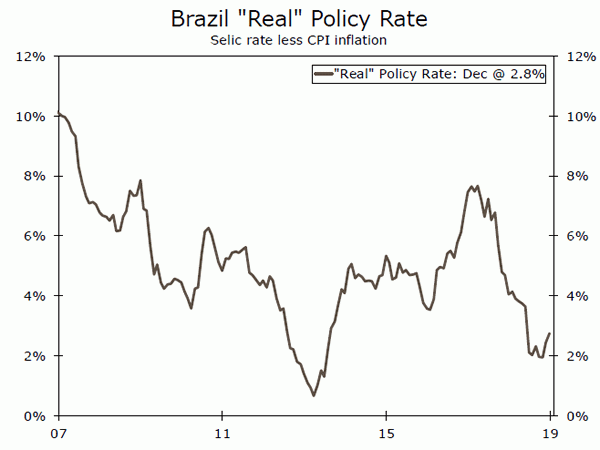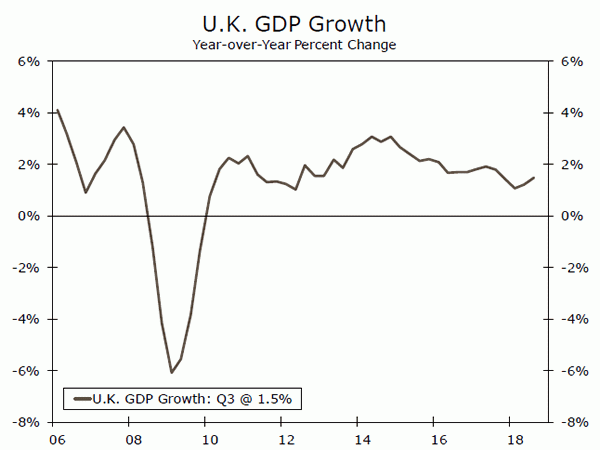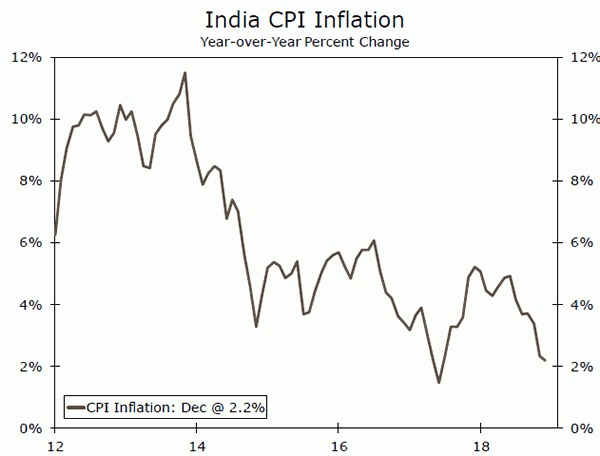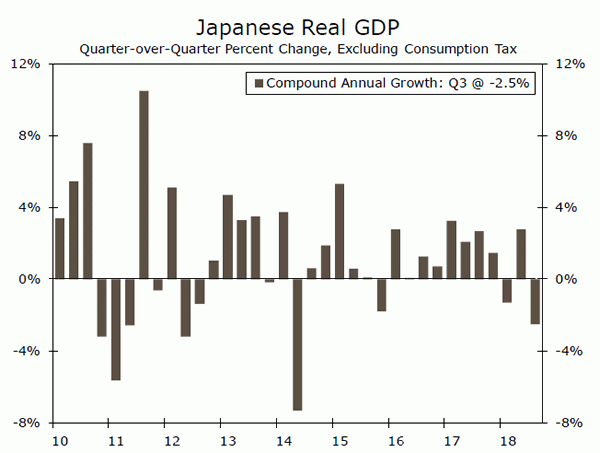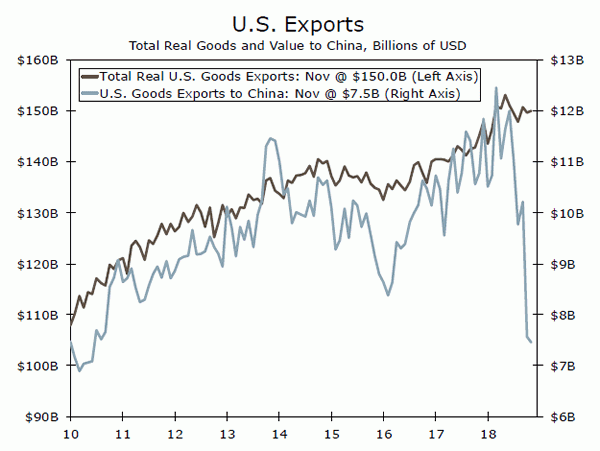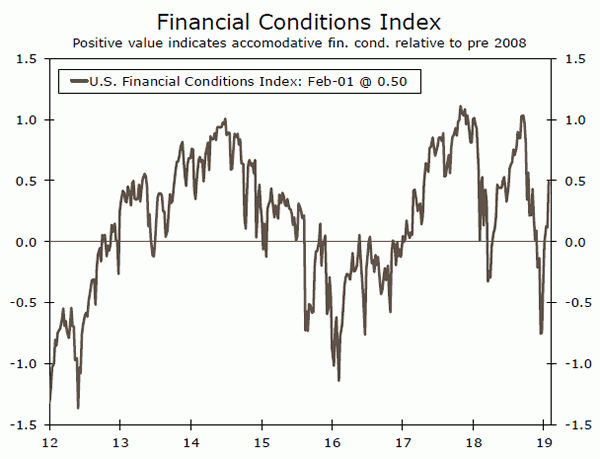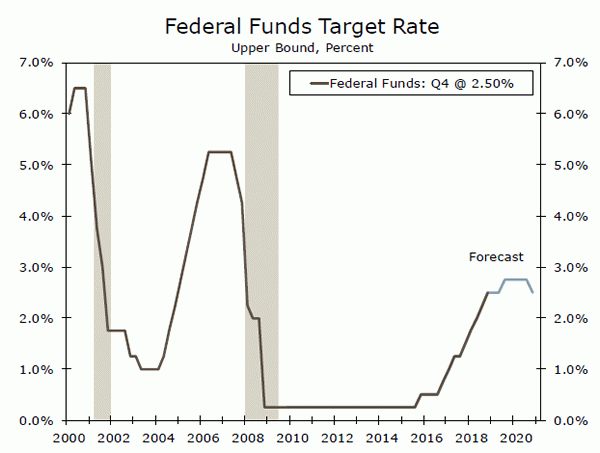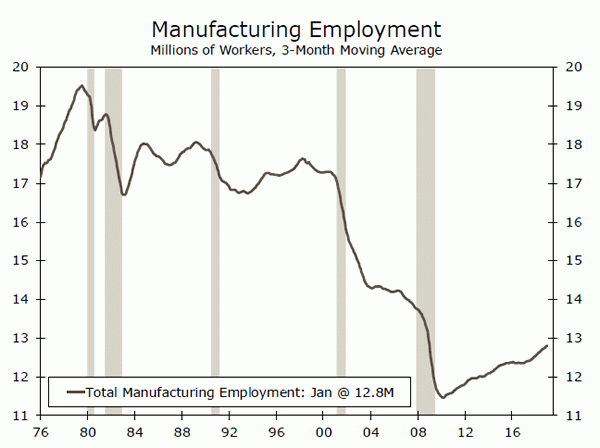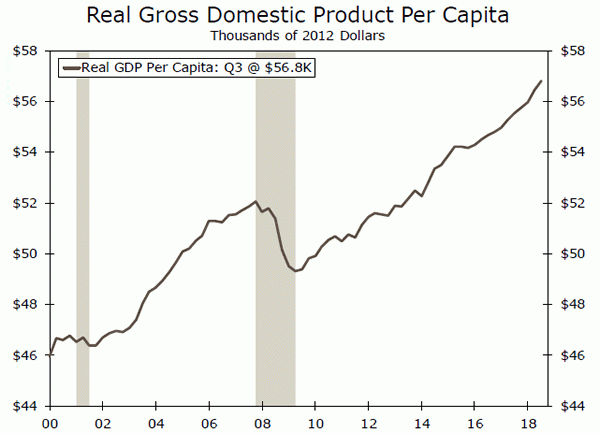U.S. Review
Catching Up On What Was Missing From Q4
- The ISM non-manufacturing index fell 1.3 points in January to a still relatively robust 56.7.
- The U.S. trade deficit narrowed by a surprising $6.4 billion in November, as imports slowed abruptly.
- Weekly data on jobless claims and mortgage application came in weaker than expected, while the weekly railroad data began the year on a strong note. The high frequency data will take on increasing significance in coming weeks, as delays in reporting some economic data have made it more difficult to assess the economy’s current underlying momentum.
Piecing Together an Outlook with Limited Data
The flow of delayed economic reports picked up this week, with reports on factory orders and international trade providing a clearer picture of what Q4 real GDP growth was. The weakness in factory orders continued along its recent trend, with overall orders falling 0.6% in November and orders for nondefense capital goods, excluding aircraft, falling by that same amount. Factory orders have been trending lower, as uncertainty surrounding trade negotiations caused firms to become more cautious. Many firms also built precautionary inventories of key components ahead of the implementation of tariffs last year. Those stocks have been gradually depleted, and firms do not appear to be taking similar precautious ahead of a jump in tariffs that potentially could take place on March 1. If that is the case, businesses are less prepared for a ratcheting up of tariffs, and such a move might prove much more disruptive if it were to occur.
Data on international trade for November were largely consistent with this thesis. The nation’s trade deficit narrowed by $6.4 billion to $49.3 billion. Imports fell 2.9%, while exports fell 0.6%. The drop in imports likely reflects the drawdown in inventories of imported raw materials and components that were built up ahead of the implementation of tariffs last year. We will likely see a rebound over the next two months, as shipments from China were likely pulled into December and January ahead of the Lunar New Year. Even with a rebound in December imports, the trade deficit is likely to either produce less of drag on GDP growth during the fourth quarter or may actually add to growth. Q4 real GDP might grow as much as 3%, well ahead of our most recent forecast. The swing in trade is hard to judge, however, as there is also likely to be a corresponding drop in inventories. We suspect imports will rebound, which could produce a large drag for Q1-2019.
Gauging the economy’s underlying momentum is difficult because of some of the delays and impacts of the government shutdown. Last Friday’s surprising strength in nonfarm payrolls, for example, might have been bolstered by furloughed government workers taking part-time jobs. The shutdown might also be disrupting the recent trend in weekly jobless claims, which have picked up recently. Some of the best data we have today may be the monthly ISM reports for manufacturing and non-manufacturing. Both have fallen back from their earlier highs but also remain at levels consistent with strong economic growth.
The latest ISM non-manufacturing index fell 1.3 points to 56.7. While that marked a larger than expected drop, the December data were revised higher. Business activity fell 1.5 points to 59.7, which marked the second consecutive decline. New orders fell five points to 57.7. The drop in the ISM, while slightly larger than expected, leaves the index in pretty solid shape. The composite index is 2.4 points below its average for the past six months of 59.1, which seems about right. The economy likely grew at better than a 3% pace during the second half of last year and will likely grow at a slower pace during the first quarter.
The high frequency data may take on growing importance in coming weeks as we try to get a better assessment of what is happening in homebuilding in particular. The weekly mortgage applications data had perked up when mortgage rates fell but have been struggling more recently. Mortgage applications for the purchase of a new home tumbled 4.9% in the most recent week, marking the third consecutive decline.
U.S. Outlook
NFIB Survey • Tuesday
Like many other measures of confidence, the NFIB’s index of small business optimism has seen some retracement in recent months. As recently as August, this proxy for small business confidence was in record-high territory. Since that time, the tariffs on $200 billion of goods targeted against China went into effect, the stock market entered a period of pronounced volatility that had been missing for a few years and of course, the U.S. government had a record-long shutdown.
With all of those variables to contend with, it is not terribly surprising that many measures of consumer and business confidence have come off the boil. We recently learned that the ISM index, a manufacturers’ survey, bounced back in January. On Tuesday of next week, we will get a read on small business optimism.
Previous: 104.4 Consensus: 103.0
CPI • Wednesday
The Fed is charged with promoting full employment while achieving low and stable inflation. While the PCE deflator can boast that it is the Fed’s preferred measure of inflation, the CPI report is closely watched by financial markets for other clues about prices.
In December, there was evidence that a number of factors have been driving inflation higher. That was easy to miss because the headline measure was pulled down by falling energy costs and lower commodity prices. Ex-energy, CPI rose 0.2% month-over-month in December and is up 2.1% over the past year.
On Wednesday of next week, financial markets will get a look at CPI numbers for January. For a “patient” and “data-dependent” Fed, these inflation numbers are key.
Previous: -0.1% Wells Fargo: 0.1% Consensus: 0.1% (Month-over-Month)
Retail Sales • Friday
Among the many frustrations of the partial U.S. government shutdown has been the delay of key economic releases. Near the top of the list in terms of importance is the retail sales report.
Thursday of next week offers the first look at how the year finished for the nation’s stores and online vendors. This is a particularly important month as it includes most of the key holiday shopping outlays that can make-or-break a store’s year in terms of profitability.
Measures of consumer confidence have slipped in recent months, though some measures of same store sales showed momentum in the final month of the year. We are looking for a 0.3% increase in December retail sales.
Previous: 0.2% Wells Fargo: 0.3% Consensus: 0.1% (Month-over-Month)
Global Review
Global Central Banks Remain in Focus
- The Reserve Bank of Australia met this week, and while no changes to interest rates were made, the central bank signaled a shift away from a hawkish stance, to a more neutral bias. European economic data continue to disappoint as well, with German factory orders missing expectations. As economic data continue to soften, the ECB may also begin a shift to a more dovish stance on monetary policy as well.
- With a new administration seeking to implement its reform agenda, the central bank of Brazil decided to hold policy rates at this week’s meeting. Central bank officials also suggested rates will remain on hold until progress on reforms is made.
Most Global Central Banks Stuck in Neutral
The Reserve Bank of Australia (RBA) held its first meeting of 2019 this week to determine the path of monetary policy. While no changes in interest rates were made, the RBA did however make a notable adjustment to its outlook for future monetary policy decisions. In its statement following the meeting, the RBA officially changed to a neutral policy stance, dialed back from a previously modestly hawkish bias, leaving the door open to potential interest rate cuts as well as hikes. With growth rates slowing, largely due to weaker demand from China, and a softening housing market, which could create a further drag on the economy, we believe the RBA is likely to be on hold for the foreseeable future, with the balance of risks now shifting toward rate cuts. Markets have responded to the combination of China’s economic deceleration and domestic factors as well, as expectations have reversed from anticipated rate hikes in 2018 to the RBA cutting interest rates in 2019.
The theme of a decelerating European economy continues to gather momentum, as economic data out of Germany this week were weaker than consensus estimates and reveal a further slowdown in broader Eurozone economic activity. December German factory orders contracted 7% year-over-year, down from a 4.3% contraction one month prior, while industrial production remains in contraction territory as well. Germany in particular has been a source of concern within the European economy, as the country narrowly avoided a technical recession in late 2018, while CPI inflation declined more than expected. While we do not believe a Eurozone recession is imminent, risks to this outlook have shifted to the downside. With the Eurozone economy broadly slowing down, this also raises some caution regarding the ECB’s path toward removing accommodative monetary policy. Indeed, we forecast gradual moves by the European Central Bank (ECB), with the initial rate hikes anticipated to occur in Q4-2019 and Q2-2020. In the interim, the ECB will remain on hold and continue to evaluate economic data in determining the future path of monetary policy.
Outside of the G10, the central bank of Brazil met this week to decide policy rates and provide markets with forward guidance on the path of monetary policy. After crisis conditions emerged in 2014-2015, the central bank raised policy rates significantly in an effort to control inflation and defend the real. As conditions stabilized, the central bank embarked on the process of lowering policy rates, bringing interest rates down to 6.50%, from a peak of 14.25%, over the course of a few years. As a new reform-minded administration settles into office, and with a new governor taking over the central bank, the central bank of Brazil has opted to keep policy rates on hold. Statements from key officials suggest rates will be on hold for the foreseeable future, as they wait for economic reforms to be proposed and implemented, in particular addressing the country’s need for pension reform. We believe policy rates will be steady through 2019 as well, as inflationary pressures have receded, and as the currency stabilizes.
Global Outlook
U.K. GDP • Monday
Despite uncertainties related to Brexit, real GDP growth in the U.K. has been resilient. GDP grew at 1.5% year-over-year in Q3, while economic activity and sentiment indicators remained in expansion throughout the fourth quarter. Q4 GDP could be significant, as it is one of the final readings before the current March 29 Brexit deadline. A “deal” or “no-Brexit” scenario would likely result in higher growth rates, while a “no-deal” scenario could potentially cause large disruptions to the U.K. economy. Commentary from the Bank of England (BoE) after this week’s monetary policy committee meeting suggests the effects of Brexit on economic growth may be more severe going forward than initially anticipated, with the BoE cutting its growth forecasts for 2019 down to 1.2%, from 1.7%. With a wide range of potential outcomes available, we maintain our base-case scenario that a “no-deal” Brexit will be avoided.
Previous: 1.5% Wells Fargo: 1.4% Consensus: 1.4% (Year-over-Year)
India CPI • Tuesday
CPI inflation in India has been trending lower since early 2018, and with oil prices still relatively subdued, inflation is likely to remain toward the lower end of the central bank’s target range. Global oil prices have recovered marginally to start the year, and with oil representing a large part of India’s CPI basket, a slight uptick in January inflation would not be all that surprising.
In an effort to spark further inflation and provide an added boost to the economy, the Reserve Bank of India opted to cut policy rates at this week’s monetary policy meeting, taking markets and analysts by surprise. Ahead of the meeting, key advisors to Prime Minister Narendra Modi suggested the central bank cut rates and pursue expansionary monetary policy to match the government’s more expansionary budget. Looser monetary policy will help put CPI inflation on a more stable, and potentially upward, trajectory heading into 2019.
Previous: 2.2%
Japan GDP • Wednesday
Economic growth in Japan has underwhelmed for the majority of 2018, with Q3 GDP contracting by 2.5% quarter-over-quarter annualized. Natural disasters had a large influence over Japan’s output during Q3; however, early indicators suggest a slight rebound in growth may occur in Q4. Measures of economic activity, such as retail sales and industrial production, have shown some improvement, while business confidence surveys suggest a potential uptick in activity as well. A modest recovery of growth in Q4 has been factored into our forecast for full-year 2018 growth, and despite a small acceleration, we still anticipate relatively subdued growth of 0.7%. Looking ahead into 2019, we forecast growth in Japan to remain modest, although it has been suggested by government officials that additional stimulus measures may be implemented in an effort to achieve more favorable growth and inflation dynamics. As of now, we currently forecast Japan to grow around 0.8% in 2019.
Previous: -2.5% Wells Fargo: 1.4% Consensus: 1.4% (Quarter-over-Quarter)
Point of View
Interest Rate Watch
And Then There Was One…
Earlier this week, we released our updated views on the economy with our February monthly outlook. One key change to our forecast is that we have pushed back the timing of further Fed policy tightening. We now expect the FOMC to next raise the fed funds rate in Q3, whereas previously we had penciled in a hike in Q2.
The delay stems in part from the more dovish tone from Fed officials the past couple of weeks. In its January statement, the FOMC removed forward guidance for further increases and vowed to be “patient.” In his post-meeting press conference, Chairman Powell chalked up the reason for such an about-face in policy guidance since December to “cross-currents” in the economy.
Weighing on the outlook has been slower growth abroad, particularly in China, which has been a headwind to exports. Activity in the housing market has also cooled amid higher mortgage rates for much of last year. Beyond the housing market’s struggle with higher mortgage rates, financial conditions tightened significantly at the end of last year. Visibility on growth has also been reduced by the partial government shutdown.
Market participants currently believe the FOMC is done raising rates this cycle as a result, but that call looks premature in our view. Consumer spending remains solid, which has helped strong job growth and rising wages. At the same time, fiscal policy remains simulative and growth remains above the FOMC’s estimates of potential. Financial conditions have also eased over the past month.
While we believe the FOMC is not quite done tightening policy yet, we believe the Q3 hike will be the lone increase this year (previously we looked for hikes in Q2-2019 and Q4-2019). By that time, the fed funds rate would be within the committee’s estimated range of “neutral.” Also, with the economy expected to be showing more meaningful signs of deceleration late in the year, we expect the Fed will need to stand pat at that point before eventually reversing course in late 2020 and cutting rates. For more details, please see “Crosscurrents and the Outlook for Fed Policy.”
Credit Market Insights
2019 Bank Lending Outlook
Credit is the lifeblood of the economy, as reliable and affordable financing is a key ingredient for sustained economic growth. The January Senior Loan Officer Survey asked banks about their expectations for lending over the course of 2019. On balance, the reported tightening of lending standards, weaker demand and deteriorating performance are consistent with our expectation of moderating economic growth—2.5% and 2.2% real GDP growth in 2019 and 2020, respectively.
The consumer powered much of the abovetrend growth (we estimate it at 2.9%) of this past year, and we expect consumption to again drive growth this year as business fixed investment and the housing market slow. Recognizing this, banks expect demand to fall across business and household lending categories, with demand for credit card debt being the lone exception. With corporate debt at an all-time high and the economic expansion near record length, banks expect to tighten lending standards across sectors. Lenders anticipate chargeoffs and delinquencies will modestly increase during 2019. Listing their top reasons for tightening standards, banks named lower risk tolerance and deterioration in the value of collateral and in the quality of their portfolios. Aside from the survey evidence, hard data suggest lending remains healthy. In the week ending January 23, total bank credit was up 5% year-over-year, with particular strength in commercial & industrial loans. For now, credit continues to flow.
Topic of the Week
Creative Destruction Still Present Today
Today marks what would have been the 136th birthday of Joseph Schumpeter, one of the most famous economists of the 20th century. Schumpeter’s contribution to the field was varied and cut across a broad swath of topics, but perhaps the most well-known aspect of his career was the popularization of the concept of “creative destruction.”
In their models, economists often think in terms of equilibria. Economic growth converges toward potential, the unemployment rate reaches its “natural” rate and prices adjust smoothly along the path toward this peaceful equilibrium. While these approaches have obvious merit and are useful tools in economic analysis, Schumpeter drew attention to the “industrial mutation,” which “incessantly revolutionizes the economic structure from within, incessantly destroying the old one, incessantly creating a new one.”
Put another way, the actual process by which economies grow over time is far bumpier. The past decade or so is an excellent example of this. Since 2007, the U.S. economy has experienced a housing bust, shifting demographics, significant swings in monetary and fiscal policy and vastly different political regimes at home and abroad. Some new industries have exploded (e-sports) while others have faced challenges (traditional taxi cabs in an age of ridesharing apps, or the secular decline in manufacturing employment, top chart). Through it all, real GDP per capita in the United States is about 10% higher today than it was in 2007 (bottom chart).
With the current expansion approaching record duration, the U.S. economy has neared its “equilibrium” level. The output gap has steadily closed, core inflation is relatively steady near 2% and the fed funds rate is at the lower end of the Federal Reserve’s estimates of neutral. Perhaps the expansion will continue for years to come, with growth, inflation and interest rates humming along smoothly at their equilibrium levels. More likely though, the process will be marked by turbulence, large swings in both directions and, of course, creative destruction.




